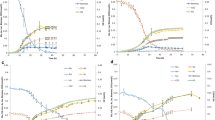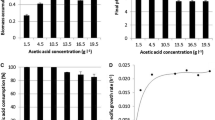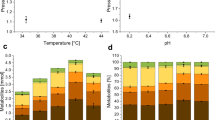Abstract
Acetic acid is an important chemical raw material that can be produced directly from sugars in lignocellulosic biomass. Development of kinetic models that capture the bioconversion dynamics of multiple sugar systems will be critical to optimization and process control in future lignocellulosic biorefinery processes. In this work, a kinetic model was developed for the single- and dual-substrate conversion of xylose and glucose to acetic acid using the acetogen Moorella thermoacetica. Batch fermentations were performed experimentally at 20 g L−1 total sugar concentration using synthetic glucose, xylose, and a mixture of glucose and xylose at a 1:1 ratio. The product yield, calculated as total product formed divided by total sugars consumed, was 79.2, 69.9, and 69.7 % for conversion of glucose, xylose, and a mixture of glucose and xylose (1:1 ratio), respectively. During dual-substrate fermentation, M. thermoacetica demonstrated diauxic growth where xylose (the preferred substrate) was almost entirely consumed before consumption of glucose began. Kinetic parameters were similar for the single-substrate fermentations, and a strong linear correlation was determined between the maximum specific growth rate μ max and substrate inhibition constant, K s . Parameters estimated for the dual-substrate system demonstrated changes in the specific growth rate of both xylose and glucose consumption. In particular, the maximum growth rate related to glucose tripled compared to the single-substrate system. Kinetic growth is affected when multiple substrates are present in a fermentation system, and models should be developed to reflect these features.


Similar content being viewed by others
Abbreviations
- S :
-
Substrate concentration (g L−1)
- X :
-
Cell mass concentration (g L−1)
- P :
-
Product concentration (g L−1)
- r x :
-
Reaction rate of cell growth (g L−1 h−1)
- r s :
-
Reaction rate of substrate consumption (g L−1 h−1)
- r p :
-
Reaction rate of product formation (g L−1 h−1)
- μ g,i :
-
Specific growth rate (h−1)
- μ max,gi :
-
Maximum specific growth rate (h−1)
- K s :
-
Substrate saturation constant (g L−1)
- K 1 :
-
Substrate inhibition constant
- P max :
-
Maximum product concentration before inhibition (g L−1)
- K d :
-
Cell death rate constant (h−1)
- Y xs :
-
Cell growth yield from substrate (\({\text{g cells g}}^{ - 1} {\text{substrate}}\))
- Y px :
-
Product yield from cells (\({\text{g product g}}^{ - 1} {\text{cells}}\))
- Y ps :
-
Product yield from substrate, or effective product yield (\({\text{g product g}}^{ - 1} {\text{substrate}}\))
References
Sauer M, Porro D, Mattanovich D, Branduardi P (2008) Microbial production of organic acids: expanding the markets. Trends Biotechnol 26:100–108. doi:10.1016/j.tibtech.2007.11.006
Bacovsky D, Ludwiczek N, Ognissanto M, Worgetter M (2013) Task 39 IEA Bioenergy. http://task39.org/2013/12/report-on-the-status-of-advanced-biofuels-demonstration-facilities-in-2012/. Accessed 01 June 2016
Juneja A, Kumar D, Murthy G (2013) Economic feasibility and environmental life cycle assessment of ethanol production from lignocellulosic feedstock in Pacific Northwest US. J Renew Sustain Energy 5:1–40
Ewanick S, Schmitt E, Gustafson R, Bura R (2014) Use of Raman spectroscopy for continuous monitoring and control of lignocellulosic biorefinery processes. Pure Appl Chem 86:1321–1432. doi:10.1515/pac-2013-1022
Drake HL, Daniel SL (2004) Physiology of the thermophilic acetogen Moorella thermoacetica. Res Microbiol 155:422–436. doi:10.1016/j.resmic.2004.03.003
Andreesen JR, Schaupp A, Neurauter C et al (1973) Fermentation of glucose, fructose, and xylose by Clostridium thermoaceticum: effect of metals on growth yield, enzymes, and the synthesis of acetate from CO2. J Bacteriol 114:743–751
Brumm PJ (1988) Fermentation of single and mixed substrates by the parent and an acid-tolerant, mutant strain of Clostridium thermoaceticum. Biotechnol Bioeng 32:444–450
Balasubramanian N, Kim JS, Lee YY (2001) Fermentation of xylose into acetic acid by Clostridium thermoaceticum. Appl Biochem Biotechnol 91–93:367–376
Brownell JE, Nakas JP (1991) Bioconversion of acid-hydrolyzed poplar hemicellulose to acetic acid by Clostridium thermoaceticum. J Ind Microbiol 7:1–6. doi:10.1007/BF01575595
Harder W (1982) Strategies of mixed substrate utilization in microorganisms. Phi Trans R Soc Lond B 297:459–480. doi:10.1098/rstb.1982.0055
Gernaey KV, Lantz AE, Tufvesson P et al (2010) Application of mechanistic models to fermentation and biocatalysis for next-generation processes. Trends Biotechnol 28:346–354. doi:10.1016/j.tibtech.2010.03.006
Nishio N, Kuroda K, Nagai S et al (1990) Methanogenesis of glucose by defined thermophilic coculture of Clostridium thermoaceticum and Methanosarcina sp. J Ferment Bioeng 70:398–403
Wang G, Wang D (1984) Elucidation of growth inhibition and acetic acid production by Clostridium thermoaceticum. Appl Environ Microbiol 47:294–298
Kwon Y, Engler C (2005) Kinetic models for growth and product formation on multiple substrates. Biotechnol Bioprocess Eng 10:587–592
Dowe N, McMillan J (2008) SSF experimental protocols-lignocellulosic biomass hydrolysis and fermentation, laboratory analytical procedure (LAP) NREL/TP-510-42630. http://www.nrel.gov/biomass/pdfs/42630.pdf
Yao KZ, Shaw BM, Kou B et al (2003) Modeling ethylene/butene copolymerization with multi-site catalysts: parameter estimability and experimental design. Polym React Eng 11:563–588. doi:10.1081/PRE-120024426
Schwartz RD, Keller FA (1982) Acetic acid production by Clostridium thermoaceticum in pH-controlled batch fermentations at acidic pH. Appl Environ Microbiol 43:1385–1392
Sugaya K, Tusé D, Jones J (1986) Production of acetic acid by Clostridium thermoaceticum in batch and continuous fermentations. Biotechnol Bioeng 28:678–683
Acknowledgments
This project is supported by Agriculture and Food Research Initiative Competitive Grant No. 2011-68005-30407 from the USDA National Institute of Food and Agriculture. Any opinions, findings, conclusions, or recommendations expressed in this publication are those of the author(s) and do not necessarily reflect the view of the U.S. Department of Agriculture. The University of Washington Denman Professorship Fund provided financial support.
Author information
Authors and Affiliations
Corresponding author
Rights and permissions
About this article
Cite this article
Schmitt, E., Bura, R., Gustafson, R. et al. Kinetic modeling of Moorella thermoacetica growth on single and dual-substrate systems. Bioprocess Biosyst Eng 39, 1567–1575 (2016). https://doi.org/10.1007/s00449-016-1631-8
Received:
Accepted:
Published:
Issue Date:
DOI: https://doi.org/10.1007/s00449-016-1631-8




